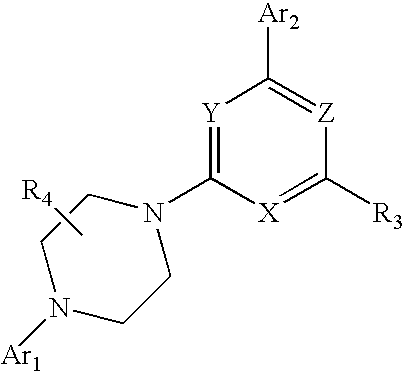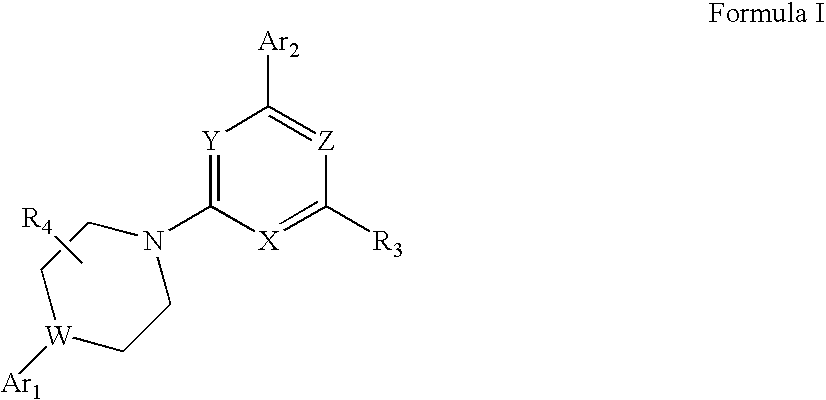Heteroaryl Substituted Piperazinyl-Pyridine Analogues
a technology of pyridine and piperazinyl, which is applied in the field of heteroaryl substituted piperazinylpyridine analogues, can solve the problems of more debilitating, acute or chronic pain, and damage to the nervous system, and achieve the effect of reducing the calcium conductance of a cellular capsaicin receptor and promoting weight loss
- Summary
- Abstract
- Description
- Claims
- Application Information
AI Technical Summary
Benefits of technology
Problems solved by technology
Method used
Image
Examples
example 1
Preparation of Representative Heteroaryl Substituted Piperazinyl-Pyridine Analogues
[0213]This Example illustrates the preparation of representative heteroaryl substituted piperazinyl-pyridine analogues.
A. 4-(4-Fluoro-phenyl)-2-(2-methyl-pyrrolidin-1-yl)-6-[4-(1H-tetrazol-5-yl)-piperidin-1-yl]pyrimidine (Compound 1)
1. Piperidine-4-carbonitrile
[0214]
[0215]Stir 4-cyano-piperidine-1-carboxylic acid tert-butyl ester (Oakwood Products, Inc., 5 g, 0.024 mol) in dry dioxane with an excess of 4 N HCl dioxane solution (100 mL). After 2 hours, collect the solid by filtration and wash it with ether (3×). Suspend the solid in toluene and add 14 g of amberlyst bicarbonate resin. Stir overnight, and then filter, washing the resin with additional toluene. Stir the collected resin for an additional 1 hour with a solution of MeOH / Et3N (4:1). Combine the two organic solutions and concentrate under reduced pressure. Take up in DCM, dry (Na2SO4), and concentrate under reduced pressure to give the freeba...
example 2
Preparation of Additional Representative Heteroaryl Substituted Piperazinyl-Pyridine Analogues
[0234]This Example illustrates the preparation of additional representative heteroaryl substituted piperazinyl-pyridine analogues.
A. 4-(3-Chloro-4-fluoro-phenyl-6-[4-(4-chloro-[1,2,5]thiadiazol-3-yl)-piperazin-1-yl]-2-(2-methyl-pyrrolidin-1-yl)-pyrimidine (Compound 4)
1. 2,4-Dichloro-6-(3-chloro-4-fluoro-phenyl)-pyrimidine
[0235]
[0236]This compound is prepared from 2,4-dichloropyrimidine and 4-bromo-2-chloro-1-fluoro-benzene using a procedure analogous to that used for the preparation of 2,4-dichloro-6-(4-fluorophenyl)pyrimidine in Example 1A, step 2.
2. 4-[2-Chloro-6-(3-chloro-4-fluoro-phenyl)-pyrimidin-4-yl]-piperazine-1-carboxylic acid tert-butyl ester
[0237]
[0238]Stir a mixture of 2,4-dichloro-6-(4-fluoro-phenyl)-pyrimidine (2.8 g, 11.52 mmol), piperazine-1-carboxylic acid tert-butyl ester (12.1 mmol), and K2CO3 (3.2 g, 23.0 mmol) in DMA at room temperature for 16 hours. Dilute with water, ...
example 3
Additional Representative Heteroaryl Substituted Piperazinyl-Pyridine Analogues
[0255]Using routine modifications, the starting materials may be varied and additional steps employed to produce other compounds provided herein. Compounds listed in Table I are prepared using such methods.
TABLE ICompoundName4-(4-Fluoro-phenyl)-2-(2-methyl-pyrrolidin-1-yl)-6-[4-(5-methyl-thiazol-4-yl)-piperazin-1-yl]-pyrimidine4-(4-Fluoro-phenyl)-6-[2-methyl-4-(5-trifluoromethyl-thiazol-4-yl)-piperazin-1-yl]-2-pyrrolidin-1-yl-pyrimidine4-(4-Fluoro-phenyl)-6-[4-(5-methyl-[1,2,3]thiadiazol-4-yl)-piperazin-1-yl]-2-piperidin-1-yl-pyrimidine4-(4-Fluoro-phenyl)-6-[4-(4-methyl-isothiazol-3-yl)-piperazin-1-yl]-2-(2-methyl-pyrrolidin-1-yl)-pyrimidine4-(4-Fluoro-phenyl)-2-(2-methyl-pyrrolidin-1-yl)-6-[4-(5-trifluoromethyl-thiazol-4-yl)-piperazin-1-yl]-pyrimidine4-(4-Fluoro-phenyl)-6-[2-methyl-4-(5-trifluoromethyl-thiazol-4-yl)-piperazin-1-yl]-2-pyrrolidin-1-yl-pyrimidine4-[4-(5-Chloro-[1,2,3]thiadiazol-4-yl)-pipera...
PUM
| Property | Measurement | Unit |
|---|---|---|
| time | aaaaa | aaaaa |
| temperature | aaaaa | aaaaa |
| flow rate | aaaaa | aaaaa |
Abstract
Description
Claims
Application Information
 Login to View More
Login to View More - R&D
- Intellectual Property
- Life Sciences
- Materials
- Tech Scout
- Unparalleled Data Quality
- Higher Quality Content
- 60% Fewer Hallucinations
Browse by: Latest US Patents, China's latest patents, Technical Efficacy Thesaurus, Application Domain, Technology Topic, Popular Technical Reports.
© 2025 PatSnap. All rights reserved.Legal|Privacy policy|Modern Slavery Act Transparency Statement|Sitemap|About US| Contact US: help@patsnap.com



